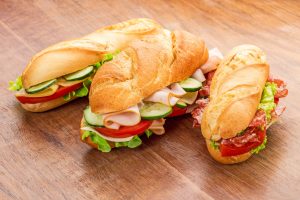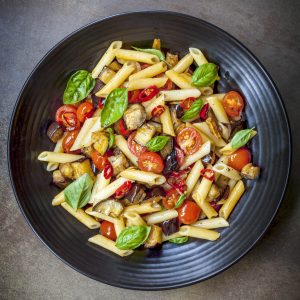Fueling For The Distance: How To Eat For Endurance Races
By Jamie Sheahan
There’s new thinking in the nutrition world on how you should prepare for distance events. Jamie Sheahan, a registered dietitian with 20 marathons under her belt, explains.
You might assume I nailed my fueling strategy from day one—after all, I’m a registered dietitian who specializes in sports nutrition. Sadly, that couldn’t be further from the truth. I signed up for my first half marathon on a whim, long before I had begun to study the science of sports nutrition. With less-than-adequate time to train, I was so worried about whether I could complete the distance that I never even considered whether I should eat or drink something during the race.
Finishing with legs that felt like concrete blocks was enough to convince me that my training and fueling  strategy, or lack thereof, needed serious tweaking. I also swore to myself upon completing that half that I would never run a full marathon because it would be crazy to double such an exhausting feat. Oh, how times have changed!
strategy, or lack thereof, needed serious tweaking. I also swore to myself upon completing that half that I would never run a full marathon because it would be crazy to double such an exhausting feat. Oh, how times have changed!
This past year, I made it a goal to run a marathon every month. And armed with a degree in nutrition science, I’m a lot better prepared. Here’s what I’ve learned that can help you train better.
All About The Base
When you think about sports nutrition, break it down into four pieces; base diet, pre-workout, fueling and recovery. The most critical is the base diet, or what we eat on a daily basis. You can do absolutely everything right on race day when it comes to fueling, but without a strong base, it will all be for naught.
The first thing you should think about is meeting your energy needs. Energy, supplied in the form of calories, is often a difficult subject. Many runners view training as an ideal way to lose weight without having to limit their food choices.
However, consuming too few calories during training increases your risk of getting stress fractures and soft tissue injuries. It can be all too easy to write these setbacks off to overtraining, when in fact they are really due to under-fueling.
What’s at play here? Losing more than one pound a week for men and two pounds a week for women not only reduces body fat. For athletes, this loss also reflects a loss of water weight, muscle glycogen and muscle tissue. Running dehydrated, with low energy stores and less muscle is a recipe for poor performance and injury.
On the flip side, it is just as easy for runners to overestimate how much energy they are burning and overcompensate by eating too much to “refuel.” We have all probably fallen prey to a post-workout reward— an indulgent meal that piles on far more calories than we expended even on a grueling 20-miler. Seriously, why do there have to be so many calories in a single pint of ice cream?
Monitoring your weight during training is the easiest way to ensure you are not ending up too far on either end of the spectrum. For best results, meet with a dietitian to have your energy needs evaluated based on your height, age, weight, gender and training volume.
 The Carbs/Protein/Fat Equation
The Carbs/Protein/Fat Equation
Probably the most hotly debated issue when it comes to the ideal base diet for runners is where our calories should come from. Should you eliminate all carbs from your diet or all-out carb-load prior to a race? And what diet should you follow?
The 40-30-30 approach, also known as The Zone Diet, encourages followers to consume 40 percent of their calories from carbohydrates, 30 percent from protein and 30 percent from fat. Sounds promising, just like the Paleo Diet or Whole30, right?
In fact, these diets fall short on many of their “scientific” claims and, more importantly from a performance standpoint, are not designed for endurance athletes.
Remember, endurance runners are a unique breed, and they have unique nutritional needs. Simplifying recommendations into mere percentages doesn’t account for differences in training volume and goals. For instance, elite athletes running marathons at a higher intensity (based on percent of VO2 max) require a greater percentage of carbohydrates than do those running at moderate intensity.
A prime example: researchers found that elite Kenyan marathoners can consume an average of 76 percent of their calories from carbohydrates during training. Of course, most of us aren’t likely to run at the high intensities these athletes do, and therefore our base diet needs not be quite so carb-centric.
Instead, runners should adjust their carbohydrate intake according to their training volume and intensity, with higher volume (training three hours per day) getting 10 to 11 grams of carbohydrate per kilogram of body weight and those training one hour per day only 6 to 7 grams of carbohydrate per kilogram of body weight.
Despite so much emphasis on carbohydrates, protein should not be neglected. During every training run and strength session (yes, you should be strength training too) your body breaks down muscle and requires amino acids, the building blocks of protein, to repair it. This constant breaking down and rebuilding is what allows us to get stronger, but that’s only possible when we give our body adequate protein to do so. Once again, needs vary depending on training volume and intensity, but most long-distance runners require 1.2 to 1.4 g/kg of body weight.
To put that in perspective, a 130-pound female would need to consume 71 to 83 grams of protein per day and a 180-pound male would need to consume 98 to 115 grams of protein per day. Fortunately, we can get protein from a variety of sources including animal proteins like red meat and poultry, eggs, dairy, soy, beans, legumes, nuts, seeds and whole grains.
One caveat before you assume your next 14-ounce steak dinner will cover your protein needs: our bodies can only use about 30 grams of protein at one time. For most, this means eating at least ve times per day with adequate protein at all meals and snacks. For every meal and snack you should be asking yourself, “Am I including a source of protein?”
Fats are also an essential part of a runner’s diet and can play a major role in helping ght in ammation. Once carbohydrate and protein needs are met, athletes are usually able to consume approximately 20 to 35 percent of their calories from fat. Athletes should focus on the quality of these fats, with an emphasis  on mono- and poly-unsaturated fats, such as those in avocados or olive oils, instead of the saturated fats from dairy or meats.
on mono- and poly-unsaturated fats, such as those in avocados or olive oils, instead of the saturated fats from dairy or meats.
As training runs become longer, fueling up before and during becomes increasingly important. A good base diet can allow a runner to store about 1,400-1,800 calories of muscle glycogen on a given day. When these reserves are depleted, we end up hitting the proverbial wall as our muscles no longer have the fuel needed to contract and thus our pace slows or we come to a stop.
Fortunately, our bodies are capable of burning fat for fuel. Even the leanest athletes have over 100,000 calories of fat stored, so why bother with all of those carbs? As our run duration increases, our body relies more and more on fat, but the breakdown of fatty acids is contingent upon the availability of carbohydrates.
Think of carbohydrates as kindling in a fire that allows the bigger logs (fat) to burn. That means if we completely deplete our glycogen reserves, our body can no longer use the plethora of fat our body has for energy. To avoid hitting the wall or compromising performance, we must top off glycogen stores before long runs with a well-timed meal or snack. The nutritional content of these meals depends largely on timing as the further out from the start of your run, the more you want to consume.
While this may be common practice amongst marathoners and ultra-marathoners, I’ve found that those running half-marathons tend to skimp on their morning meal and forego mid-race fueling altogether. Learn from my “newbie” mistake and don’t succumb to the dreaded “lead legs” near the end of race where maintaining your pace becomes all but impossible. Topping off glycogen stores before running (and during a run) can prevent this and allow for a strong finish.
Timing Is Everything
Regardless of whether you are going 13.1, 26.2 or longer, your pre-race dinner and breakfast are critical. The night before a long run your goal should be to max out your glycogen stores with a high-carb meal. Opt for foods that are low in fiber to avoid potential stomach distress the next day.
If you have chosen a destination race then practice with dinner options that you will be able to find at a restaurant near the event. A pre-race dinner is not the time to be adventurous and experience the local cuisine. There are so many unknown variables that can affect your performance on race day, and your dinner shouldn’t have to be one of them.
I’ve been accused of being borderline neurotic when it comes to my pre-race meal. Ever since my first marathon I have the exact same thing: pasta in a red sauce with shrimp. It’s the perfect balance of carbs, protein and fat, but more importantly it’s familiar, and I know it works well for me. When I travel for a race I research menus of local restaurants to be sure I can have my tried and true meal.
As for breakfast, about 3 to 4 hours before a run, aim for a well-balanced meal that includes a source of carbohydrates as well as a little protein and fat. Think a bowl of oatmeal with chopped walnuts or a bagel with peanut butter. If eating within an hour of your run, stick with just carbohydrates and choose items that are easy on the stomach, like a banana or diluted sports drink. If you ever see me waiting for the start of a race, I can guarantee you will spot me nibbling on a banana, as this is one of the few solid foods I have found that gives me a good source of steady energy without upsetting my stomach.
Attend any race expo and it’s clear there is no shortage of fuels to consume during a race. So how do you know what or how much you need?
For starters, you only need to fuel during a run if you are going to be running 75 minutes or more. For shorter races or training events, athletes can benefit from swishing a sports drink in their mouth then spitting it out. In a study published in the Journal of Physiology in 2009, researchers found that endurance cyclists who swished and then spat out a sports drink performed better on time trials than those who hadn’t. Studies have shown although this method does not actually supply the body with any carbohydrates (since the drink is not ingested), the sweetness imparted by the drink essentially activates the reward center in our brain and fools it by reducing our perceived exertion level.
If you are going longer than that 75-minutes mark, swishing and spitting a sports drink won’t cut it. Depending on a number of factors, including pace and body weight, athletes should aim to consume anywhere from 30 to 60 grams of carbohydrates per hour.
These carbohydrates should simply be just that; simple. As we run, blood flow is shunted away from our digestive tract to our working muscles. This is great for our tired legs that require additional oxygen and nutrients, but it can make digesting food a bit dicey.
Anyone who has made a mid-race trip to a Porta-Pottie knows all too well how devastating it can be to watch your goal time slip away as you attend to “business.” To avoid stomach distress, practice with various options, but be selective as not all products are created equal.

The Glucose/Fructose Balance
The ideal fuel for a run should contain a mixture of glucose and fructose. Both are simple sugars. Your body processes the carbohydrates in foods such as grains into glucose. Sucrose occurs naturally in fruits and vegetables. Glucose and fructose are absorbed via different pathways in the digestive tract, so restricting yourself to just one means limiting how fast fuel can get to your working muscles.
Including a small amount of fructose in a fuel is like opening up an extra lane of traffic at rush hour: things move more quickly and therefore so will you. Experiment with different products to find what works best for you. Gels, beans, blocks—the possibilities are seemingly endless and it can take time to find what gives you plenty of energy without upsetting your stomach.
Consider products that include caffeine, as studies have repeatedly shown that caffeine works as an ergogenic aid, improving performance for short and long-distance athletes. Many races provide specific fuels along the course. For those averse to carrying items, training with the product provided by the course can be an ideal solution. Just be sure to take into account everything from how often a race will hand items out to what flavors are provided.
I will never forget one race where I failed to pack enough gels, and out of desperation as I neared the final miles I grabbed a gel from an aid station. Expecting a typical chocolate- or vanilla-flavored gel, instead I ended up with what tasted like a melted orange creamsicle—and not in a good way. I’ll take this opportunity to apologize to the runners who were near me at the time as they had to see that gel reappear on the pavement around me.
The most important thing to remember is that every runner has unique needs so there is no one-size-fits-all approach. However, keeping in mind these general rules will help you to go the distance.
Jamie Sheahan graduated from the University of Vermont in 2011 and went on to complete her Master of Science in Dietetics in 2013. Working as the Director of Nutrition at The Edge in Burlington, Jamie works closely with athletes to develop customized fueling plans to optimize their health and performance. Jamie will also be taking on the role of adjunct professor of sports nutrition at UVM in the fall of 2017. An avid runner, Jamie has completed 20 marathons. For the past 12 months, she has run at least one marathon each month and she qualified for Boston along the way. Jamie serves as Lulu Lemon’s run ambassador, a role in which she aims to help others discover or foster a love of running with group training runs and informational talks.

